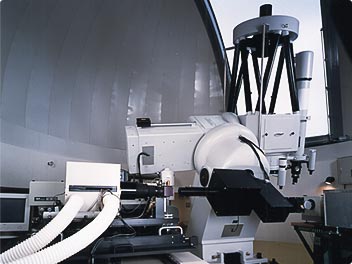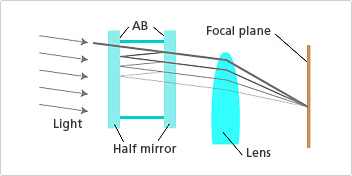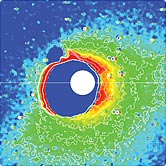Observation of specific wavelength of light
Where are the observations conducted ?

Ultrawide-field of view obsevation equipment
Primarily at our Iitate observatory in Fukushima prefecture, during the period when Jupiter becomes visible in the night sky. It takes Jupiter 11 of our years to make one complete orbit around the sun, whereas Earth orbits once each year. Every year, when Earth is as close to Jupiter as it can get, observation is also performed on the Hawaiian island of Maui. The altitude of the observation site there is 3,000 meters, making it more stable than our facility in Iitate. The improved view allows us to collect more data. When observing sodium atoms from Jupiter, we use a telescope with an ultra-wide field of view, and we employ the Fabry-Perot interferometer in the observation of sulfur ions.
What kind of optical instrument is the Fabry-Perot interferometer ?

Semiwide-field of view obsevation equipment attached to 60cm-diameter reflecting optical telescope (Iitate observatory)
Sulfur ions in a plasma torus glow at a specific wavelength when they collide with electrons. In order to isolate that light, high-resolution equipment is necessary. Invented about 100 years ago by Charles Fabry and Alfred Perot, the interferometer's design enables it to offer consistent brightness when wavelength resolution is increased, unlike the spectrometer, which is generally used to measure light.
Can you briefly explain the principles of its operation ?

- Principles of the Fabry-Perot interferometer
- Using the light entering the figure, from the left as an example, we can see that some of it passes through both mirrors A and B and the lens, arriving at the focal plane. A closer look reveals that some light passes through mirror A, then is reflected off of mirror B, bounces again off mirror A and finally passes through mirror B. Not all of it, though - some of the light bounces once again off mirrors B and A respectively, before finally passing through mirror B. Altogether, there are four lights, all having traveled different distances. This difference is responsible for the concentric circular pattern on the focal plane. The wavelength to be isolated depends on the distance between A and B, and on the angle at which the light hits the mirror.
A mirror which has a high-reflectivity coating applied to one side is called a "half mirror". When two such mirrors are placed in parallel with the coated sides facing each other, some light will pass through both mirrors. Most light, however, will be reflected repeatedly off of both mirrors. Obviously the distance that the light travels before reaching the lens differs depending on how many times it repeated reflection between the mirrors. Since light is in essence a wave, the waves will be stronger if they are in phase. If they aren't, however, it is possible that they will cancel each other out. When observing light exiting the Fabry-Perot interferometer through a lens, it appears in the form of concentric circles. As this pattern is determined by the wavelength of the light, the distance between the mirrors, and the angle of light incident on the mirror, it is possible to isolate light of a specific wavelength.
The entrance of a spectrometer is merely a narrow slit, so it can only detect a small amount of light. On the other hand, the Fabry-Perot interferometer uses the surfaces of the mirrors to collect a great deal more light. Brightness and resolution are high. The wavelength of light to be isolated can also be changed, by adjusting the angle of the interferometer.
Was Nikon involved in the production of the instrument ?

Thin atomosphere detected around the moon
The Fabry-Perot interferometer requires high-precision glass elements with total uniformity in terms of flatness and thickness. Placing them parallel to each other at an exact distance is very difficult. Though the interferometer we are currently using was manufactured in the U.K., we asked Nikon and Nikon Engineering to produce the whole optical system as they are highly advanced in terms of experience and technological capabilities. An interferometer optical system for wide-field of view planet observation is made up of semiwide-field of view and ultrawide-field of view equipment.
In addition to my research, I have been using Nikon products for some time now. When I was in high school, I bought Nikon's 6.5cm-diameter refracting telescope. However, one of the fixing screws was a little bent, and I couldn't attach the eyepiece. I wrote to Nikon to explain the situation, and not long after I received a nice letter and a new screw from them. From that moment forward I've trusted Nikon products, and have continued to use them for many years.
Getting back to the optical equipment......the one Nikon developed is also being used for observation of our moon. It is Earth's lone satellite and as small as Jupiter is large. It is sometimes referred to as a naked star with no atmosphere. However, when atoms are expelled from the surface, that simple action creates a thin atmosphere - observed, of course, with the ultrawide field of view equipment produced by Nikon.
- Nikon Engineering
![[Open in a new window]](/common/img/icon/window.png) (in Japanese language only)
(in Japanese language only)

